OpenBIM: An Enabling Solution for Information Interoperability
Abstract
1. Introduction
2. Literature Search
2.1. Distribution of Publications by Databases
2.2. Distribution of Publications by Standards
2.3. Distribution of Publications Over Time
2.4. Distribution of Publications by Publishers
2.5. Distribution of Publications by Countries
3. Overview of OpenBIM
3.1. OpenBIM Standards
3.1.1. buildingSMART Standards
3.1.2. BuildingSMART Candidate Standards
3.1.3. BuildingSMART Related Other Standards
3.2. OpenBIM Software Platforms and Tools
3.2.1. Platforms
- IfcOpenShell is an open source software library that helps users and software developers to parse IFC models [13].
- bimvie.ws developed an online viewing software tool of BIM built in HTML and Javascript. It is compatible with the BIM Service interface exchange (BIMSie) API interface and works with BIM on the cloud platform. BIMSie is a standard API for BIM Web Services to get BIM in the cloud. Users can use bimvie.ws with any BIMSie-compatible online BIM service [14].
- BIMsurfer is an open source IFC model viewer developed by SceneJS and WebGL to parse BIM data from IFC and glTF formats [15].
- BCFier is an application that can handle BCF files, and it can be integrated directly with BIM software as a plugin. BCFier allows users to create and open BCF files in Autodesk Revit, add multiple views and comments, and easily share them with other team members [16].
3.2.2. Tools
- IFC Document Generator (IfcDoc) is a software tool for generating IFC documents (starting with IFC4) and developing MVD [18]. This tool is based on the mvdXML specification and can be applied to all IFC versions.
- BCF Manager enables users to create, filter, and find issues in BIM model. Users can save, load issues, or synchronize them from BIMcollab to share issues with project members who use the same or different BIM tools shown in Figure 8, thereby improving the reliability of issue management and narrowing the gap between BIM tools [19].
- Building information model query language (BIMQL) is an open domain specific query language for building information model. The query language can select and update data stored in IFC. It is currently used in BIMserver.org platform [20].
- The apstex IFC Framework is a Java-based object-oriented toolkit that provides full access to IFC-based BIM models for reading, writing, modifying, and creating IFC models. The IFC Framework provides tools for accessing and visualizing IFC-based BIM to facilitate software developers to integrate information libraries into products. End-users can also perform visual operations and model checking [21].
- IFC Engine DLL is a STEP toolbox, which can generate 3D models for the latest version of IFC. This component can load, edit, and create Step Physical Files and its framework through its own object database [22].
4. Engineering Information Interoperability Research Supported by OpenBIM
4.1. Information Representation
4.2. Information Query
4.3. Information Exchange
4.3.1. Information Exchange by OpenBIM Participation
4.3.2. Information Exchange by OpenBIM Transformation
4.4. Information Extension
4.5. Information Integration
5. Research Gaps and Future Directions
6. Conclusions
Author Contributions
Funding
Acknowledgments
Conflicts of Interest
References
- Official Definition of Open BIM—Open BIM. Available online: http://open.bimreal.com/bim/index.php/2012/03/20/what-is-the-official-definition-of-open-bim/ (accessed on 16 July 2019).
- buildingSMART—The Home of BIM. Available online: https://www.buildingsmart.org/ (accessed on 16 March 2019).
- Standards Library—buildingSMART. Available online: https://www.buildingsmart.org/standards/bsi-standards/standards-library/ (accessed on 16 July 2019).
- Home—Welcome to buildingSMART-Tech.org. Available online: https://technical.buildingsmart.org/ (accessed on 16 July 2019).
- MvdXML—Welcome to buildingSMART-Tech.org. Available online: https://technical.buildingsmart.org/standards/mvd/mvdxml/ (accessed on 16 July 2019).
- BIM Collaboration Format (BCF)—Welcome to buildingSMART-Tech.org. Available online: https://technical.buildingsmart.org/standards/bcf/ (accessed on 16 July 2019).
- Cloud-based Data Dictionary Launched—buildingSMART. Available online: https://www.buildingsmart.org/cloud-based-data-dictionary-launched/ (accessed on 16 March 2019).
- ifcOWL—Welcome to buildingSMART-Tech.org. Available online: https://technical.buildingsmart.org/standards/ifc/ifc-formats/ifcowl/ (accessed on 16 July 2019).
- buildingSMART Alliance Construction Operations Building Information Exchange (COBie) Project—National Institute of Building Sciences. Available online: https://www.nibs.org/page/bsa_cobie (accessed on 16 March 2019).
- Kang, T.W. Object composite query method using IFC and LandXML based on BIM linkage model. Autom. Constr. 2017, 76, 14–23. [Google Scholar] [CrossRef]
- National Institute of Building Sciences. National Building Information Modeling Standard Version 1.0—Part 1 Overview, Principles, and Methodologies; buildingSMART Initiative: St. Louis, MO, USA, 2007. [Google Scholar]
- Open Source BIMserver—In the Heart of Your BIM! Available online: http://bimserver.org/ (accessed on 16 March 2019).
- IfcOpenShell. Available online: http://ifcopenshell.org/ (accessed on 16 March 2019).
- Giving Perspective to Your BIM Projects—Bimvie.ws. Available online: http://bimvie.ws/ (accessed on 16 March 2019).
- BIM Surfer®. Available online: http://bimsurfer.org/ (accessed on 16 March 2019).
- BCFier. Available online: http://bcfier.com/ (accessed on 16 March 2019).
- OpenBIM. Available online: http://www.openbim.org/ (accessed on 16 March 2019).
- ifcDoc Tool Summary—Welcome to buildingSMART-Tech.org. Available online: http://www.buildingsmart-tech.org/specifications/specification-tools/ifcdoc-tool/ (accessed on 16 March 2019).
- BCF Manager—BIMcollab®. Available online: https://www.bimcollab.com/en/BCF-Manager/BCF-Manager (accessed on 16 March 2019).
- Mazairac, W.; Beetz, J. BIMQL—An open query language for building information models. Adv. Eng. Inform. 2013, 27, 444–456. [Google Scholar] [CrossRef]
- Apstex IFC Framework. Available online: http://www.apstex.com/ (accessed on 16 March 2019).
- Weblet Importer. Available online: http://rdf.bg/product-list/ifc-engine/ (accessed on 16 March 2019).
- Ma, Z.; Liu, Z. Ontology- and freeware-based platform for rapid development of BIM applications with reasoning support. Autom. Constr. 2018, 90, 1–8. [Google Scholar] [CrossRef]
- Sacks, R.; Kedar, A.; Borrmann, A.; Ma, L.; Brilakis, I.; Hüthwohl, P.; Daum, S.; Kattel, U.; Yosef, R.; Liebich, T.; et al. SeeBridge as next generation bridge inspection: Overview, Information Delivery Manual and Model View Definition. Autom. Constr. 2018, 90, 134–145. [Google Scholar] [CrossRef]
- Sacks, R.; Ma, L.; Yosef, R.; Borrmann, A.; Daum, S.; Kattel, U. Semantic Enrichment for Building Information Modeling: Procedure for Compiling Inference Rules and Operators for Complex Geometry. J. Comput. Civ. Eng. 2017, 31. [Google Scholar] [CrossRef]
- Pauwels, P.; Krijnen, T.; Terkaj, W.; Beetz, J. Enhancing the ifcOWL ontology with an alternative representation for geometric data. Autom. Constr. 2017, 80, 77–94. [Google Scholar] [CrossRef]
- Khalili, A.; Chua, D.K.H. IFC-Based Graph Data Model for Topological Queries on Building Elements. J. Comput. Civ. Eng. 2013, 29. [Google Scholar] [CrossRef]
- Nepal, M.P.; Staub-French, S.; Pottinger, R.; Webster, A. Querying a building information model for construction-specific spatial information. Adv. Eng. Inform. 2012, 26, 904–923. [Google Scholar] [CrossRef]
- Ghang, L.; Jiyong, J.; Jongsung, W.; Chiyon, C.; Seok-joon, Y.; Sungil, H.; Hoonsig, K. Query Performance of the IFC Model Server Using an Object-Relational Database Approach and a Traditional Relational Database Approach. J. Comput. Civ. Eng. 2014, 28, 210–222. [Google Scholar]
- Lin, J.R.; Hu, Z.Z.; Zhang, J.P.; Yu, F.Q. A Natural-Language-Based Approach to Intelligent Data Retrieval and Representation for Cloud BIM. Comput. Civ. Infrastruct. Eng. 2016, 31, 18–33. [Google Scholar] [CrossRef]
- Kuo, V.; Oraskari, J. A Predictive Semantic Inference System using BIM Collaboration Format (BCF) Cases and Machine Learning. CIB World Build. Congr. 2016, 3, 368–378. [Google Scholar]
- Hu, Z.Z.; Zhang, X.Y.; Wang, H.W.; Kassem, M. Improving interoperability between architectural and structural design models: An industry foundation classes-based approach with web-based tools. Autom. Constr. 2016, 66, 29–42. [Google Scholar] [CrossRef]
- Lee, J.K.; Eastman, C.M.; Lee, Y.C. Implementation of a BIM Domain-specific Language for the Building Environment Rule and Analysis. J. Intell. Robot. Syst. Theory Appl. 2015, 79, 507–522. [Google Scholar] [CrossRef]
- Solihin, W.; Eastman, C.; Lee, Y.C. Multiple representation approach to achieve high-performance spatial queries of 3D BIM data using a relational database. Autom. Constr. 2017, 81, 369–388. [Google Scholar] [CrossRef]
- Choi, J.; Kim, H.; Kim, I. Open BIM-based quantity take-off system for schematic estimation of building frame in early design stage. J. Comput. Des. Eng. 2015, 2, 16–25. [Google Scholar] [CrossRef]
- Park, J.; Cai, H.; Dunston, P.S.; Ghasemkhani, H. Database-Supported and Web-Based Visualization for Daily 4D BIM. J. Constr. Eng. Manag. 2017, 143. [Google Scholar] [CrossRef]
- Caldas, C.H.; Soibelman, L. Integration of Construction Documents in IFC Project Models; American Society of Civil Engineers (ASCE): Preston, WV, USA, 2004; pp. 1–8. [Google Scholar]
- Babič, N.Č.; Podbreznik, P.; Rebolj, D. Integrating resource production and construction using BIM. Autom. Constr. 2010, 19, 539–543. [Google Scholar] [CrossRef]
- Caffi, V.; Re Cecconi, F.; Pavan, A.; Pasini, D.; Maltese, S.; Daniotti, B.; Chiozzi, M.; Spagnolo, S.L. INNOVance: Italian BIM Database for Construction Process Management. In Proceedings of the applications of IT in the Architecture, Engineering and Construction Industry, Orlando, FL, USA, 23–25 June 2014; pp. 641–648. [Google Scholar]
- Ding, L.; Li, K.; Zhou, Y.; Love, P.E.D. An IFC-inspection process model for infrastructure projects: Enabling real-time quality monitoring and control. Autom. Constr. 2017, 84, 96–110. [Google Scholar] [CrossRef]
- Lu, Q.; Lee, S.; Chen, L. Image-driven fuzzy-based system to construct as-is IFC BIM objects. Autom. Constr. 2018, 92, 68–87. [Google Scholar] [CrossRef]
- Hu, Z.Z.; Zhang, J.P.; Yu, F.Q.; Tian, P.L.; Xiang, X.S. Construction and facility management of large MEP projects using a multi-Scale building information model. Adv. Eng. Softw. 2016, 100, 215–230. [Google Scholar] [CrossRef]
- Edmondson, V.; Cerny, M.; Lim, M.; Gledson, B.; Lockley, S.; Woodward, J. A smart sewer asset information model to enable an ‘Internet of Things’ for operational wastewater management. Autom. Constr. 2018, 91, 193–205. [Google Scholar] [CrossRef]
- Vanlande, R.; Nicolle, C.; Cruz, C. IFC and building lifecycle management. Autom. Constr. 2008, 18, 70–78. [Google Scholar] [CrossRef]
- Lin, Y.H.; Liu, Y.S.; Gao, G.; Han, X.G.; Lai, C.Y.; Gu, M. The IFC-based path planning for 3D indoor spaces. Adv. Eng. Inform. 2013, 27, 189–205. [Google Scholar] [CrossRef]
- Jeong, Y.S.; Eastman, C.M.; Sacks, R.; Kaner, I. Benchmark tests for BIM data exchanges of precast concrete. Autom. Constr. 2009, 18, 469–484. [Google Scholar] [CrossRef]
- Wang, X.; Yang, H.; Zhang, Q.L. Research of the IFC-based Transformation Methods of Geometry Information for Structural Elements. J. Intell. Robot. Syst. Theory Appl. 2015, 79, 465–473. [Google Scholar] [CrossRef]
- Venugopal, M.; Eastman, C.M.; Sacks, R.; Teizer, J. Semantics of model views for information exchanges using the industry foundation class schema. Adv. Eng. Inform. 2012, 26, 411–428. [Google Scholar] [CrossRef]
- Lee, G.; Park, Y.H.; Ham, S. Extended Process to Product Modeling (xPPM) for integrated and seamless IDM and MVD development. Adv. Eng. Inform. 2013, 27, 636–651. [Google Scholar] [CrossRef]
- Lee, Y.C.; Eastman, C.M.; Lee, J.K. Validations for ensuring the interoperability of data exchange of a building information model. Autom. Constr. 2015, 58, 176–195. [Google Scholar] [CrossRef]
- Lee, Y.C.; Eastman, C.M.; Solihin, W.; See, R. Modularized rule-based validation of a BIM model pertaining to model views. Autom. Constr. 2016, 63, 1–11. [Google Scholar] [CrossRef]
- Pärn, E.A.; Edwards, D.J. Conceptualising the FinDD API plug-in: A study of BIM-FM integration. Autom. Constr. 2017, 80, 11–21. [Google Scholar] [CrossRef]
- Alreshidi, E.; Mourshed, M.; Rezgui, Y. Requirements for cloud-based BIM governance solutions to facilitate team collaboration in construction projects. Requir. Eng. 2018, 23, 1–31. [Google Scholar] [CrossRef]
- Lee, Y.C.; Eastman, C.M.; Solihin, W. Logic for ensuring the data exchange integrity of building information models. Autom. Constr. 2018, 85, 249–262. [Google Scholar] [CrossRef]
- Juan, D. The research to open BIM-based building information interoperability framework. In Proceedings of the 2013 2nd International Symposium on Instrumentation and Measurement, Sensor Network and Automation, IMSNA 2013, Toronto, ON, Canada, 23–24 December 2013; pp. 440–443. [Google Scholar]
- Beetz, J.; Berlo, L. Van BIMSERVER.ORG—An open source IFC model server. In Proceedings of the 27th International Conference on Information Technology in Construction CIB W78, Cairo, Egypt, 16–18 November 2010; pp. 16–18. [Google Scholar]
- Isikdag, U. Design patterns for BIM-based service-oriented architectures. Autom. Constr. 2012, 25, 59–71. [Google Scholar] [CrossRef]
- Ma, Z.; Cai, S.; Mao, N.; Yang, Q.; Feng, J.; Wang, P. Construction quality management based on a collaborative system using BIM and indoor positioning. Autom. Constr. 2018, 92, 35–45. [Google Scholar] [CrossRef]
- van Berlo, L.; Krijnen, T. Using the BIM Collaboration Format in a Server Based Workflow. Procedia Environ. Sci. 2014, 22, 325–332. [Google Scholar] [CrossRef]
- Solihin, W.; Eastman, C.; Lee, Y.C. A framework for fully integrated building information models in a federated environment. Adv. Eng. Inform. 2016, 30, 168–189. [Google Scholar] [CrossRef]
- Solihin, W.; Eastman, C.; Lee, Y.C.; Yang, D.H. A simplified relational database schema for transformation of BIM data into a query-efficient and spatially enabled database. Autom. Constr. 2017, 84, 367–383. [Google Scholar] [CrossRef]
- Oldfield, J.; van Oosterom, P.; Beetz, J.; Krijnen, T. Working with Open BIM Standards to Source Legal Spaces for a 3D Cadastre. ISPRS Int. J. Geo-Inf. 2017, 6, 351. [Google Scholar] [CrossRef]
- Terkaj, W.; Šojić, A. Ontology-based representation of IFC EXPRESS rules: An enhancement of the ifcOWL ontology. Autom. Constr. 2015, 57, 188–201. [Google Scholar] [CrossRef]
- Le, T.; David Jeong, H. Interlinking life-cycle data spaces to support decision making in highway asset management. Autom. Constr. 2016, 64, 54–64. [Google Scholar] [CrossRef]
- Lee, Y.C.; Eastman, C.M.; Solihin, W. An ontology-based approach for developing data exchange requirements and model views of building information modeling. Adv. Eng. Inform. 2016, 30, 354–367. [Google Scholar] [CrossRef]
- Pauwels, P.; Terkaj, W. EXPRESS to OWL for construction industry: Towards a recommendable and usable ifcOWL ontology. Autom. Constr. 2016, 63, 100–133. [Google Scholar] [CrossRef]
- Lee, S.H.; Kim, B.G. IFC extension for road structures and digital modeling. Procedia Eng. 2011, 14, 1037–1042. [Google Scholar] [CrossRef]
- Ji, Y.; Borrmann, A.; Beetz, J.; Obergrießer, M. Exchange of Parametric Bridge Models Using a Neutral Data Format. J. Comput. Civ. Eng. 2012, 27, 593–606. [Google Scholar] [CrossRef]
- Patacas, J.; Dawood, N.; Vukovic, V.; Kassem, M. BIM for facilities management: Evaluating BIM standards in asset register creation and service life planning. J. Inf. Technol. Constr. 2015, 20, 313–331. [Google Scholar]
- Venugopal, M.; Eastman, C.M.; Teizer, J. An ontology-based analysis of the industry foundation class schema for building information model exchanges. Adv. Eng. Inform. 2015, 29, 940–957. [Google Scholar] [CrossRef]
- Belsky, M.; Sacks, R.; Brilakis, I. Semantic Enrichment for Building Information Modeling. Comput. Civ. Infrastruct. Eng. 2016, 31, 261–274. [Google Scholar] [CrossRef]
- Fahad, M.; Bus, N.; Andrieux, F. Towards Mapping Certification Rules over BIM. In Proceedings of the 33rd CIB W78 Conference, Brisbane, Australia, 31 October–2 November 2016. [Google Scholar]
- Andriamamonjy, A.; Saelens, D.; Klein, R. An automated IFC-based workflow for building energy performance simulation with Modelica. Autom. Constr. 2018, 91, 166–181. [Google Scholar] [CrossRef]
- Laat, R.; Berlo, L. Integration of BIM and GIS: The Development of the CityGML GeoBIM Extension BT—Advances in 3D Geo-Information Sciences. In Advances in 3D Geo-Information Sciences; Springer: Berlin/Heidelberg, Germany, 2011; pp. 211–225. ISBN 978-3-642-12670-3. [Google Scholar]
- Jusuf, S.; Mousseau, B.; Godfroid, G.; Soh, J. Path to an Integrated Modelling between IFC and CityGML for Neighborhood Scale Modelling. Urban Sci. 2017, 1, 25. [Google Scholar] [CrossRef]
- Liu, X.; Liu, R.; Wright, G.; Cheng, J.; Wang, X.; Li, X. A State-of-the-Art Review on the Integration of Building Information Modeling (BIM) and Geographic Information System (GIS). ISPRS Int. J. Geo-Inf. 2017, 6, 53. [Google Scholar] [CrossRef]
- El-Mekawy, M.; Östman, A.; Hijazi, I. A Unified Building Model for 3D Urban GIS. ISPRS Int. J. Geo-Inf. 2012, 1, 120–145. [Google Scholar] [CrossRef]
- Zhu, J.; Wright, G.; Wang, J.; Wang, X. A Critical Review of the Integration of Geographic Information System and Building Information Modelling at the Data Level. ISPRS Int. J. Geo-Inf. 2018, 7, 66. [Google Scholar] [CrossRef]
- Kang, T. Development of a Conceptual Mapping Standard to Link Building and Geospatial Information. ISPRS Int. J. Geo-Inf. 2018, 7, 162. [Google Scholar] [CrossRef]
- Amirebrahimi, S.; Rajabifard, A.; Mendis, P.; Ngo, T. A BIM-GIS integration method in support of the assessment and 3D visualisation of flood damage to a building. J. Spat. Sci. 2016, 61, 317–350. [Google Scholar] [CrossRef]
- Teo, T.A.; Cho, K.H. BIM-oriented indoor network model for indoor and outdoor combined route planning. Adv. Eng. Inform. 2016, 30, 268–282. [Google Scholar] [CrossRef]
- IBPSA Project 1. Available online: https://ibpsa.github.io/project1/ (accessed on 27 November 2019).
- Lee, Y.C.; Solihin, W.; Eastman, C.M. The Mechanism and Challenges of Validating a Building Information Model regarding data exchange standards. Autom. Constr. 2019, 100, 118–128. [Google Scholar] [CrossRef]
- Sanfilippo, E.; Terkaj, W. Editorial: Formal Ontologies meet Industry. Procedia Manuf. 2019, 28, 174–176. [Google Scholar] [CrossRef]
- Wang, H.; Pan, Y.; Luo, X. Integration of BIM and GIS in sustainable built environment: A review and bibliometric analysis. Autom. Constr. 2019, 103, 41–52. [Google Scholar] [CrossRef]
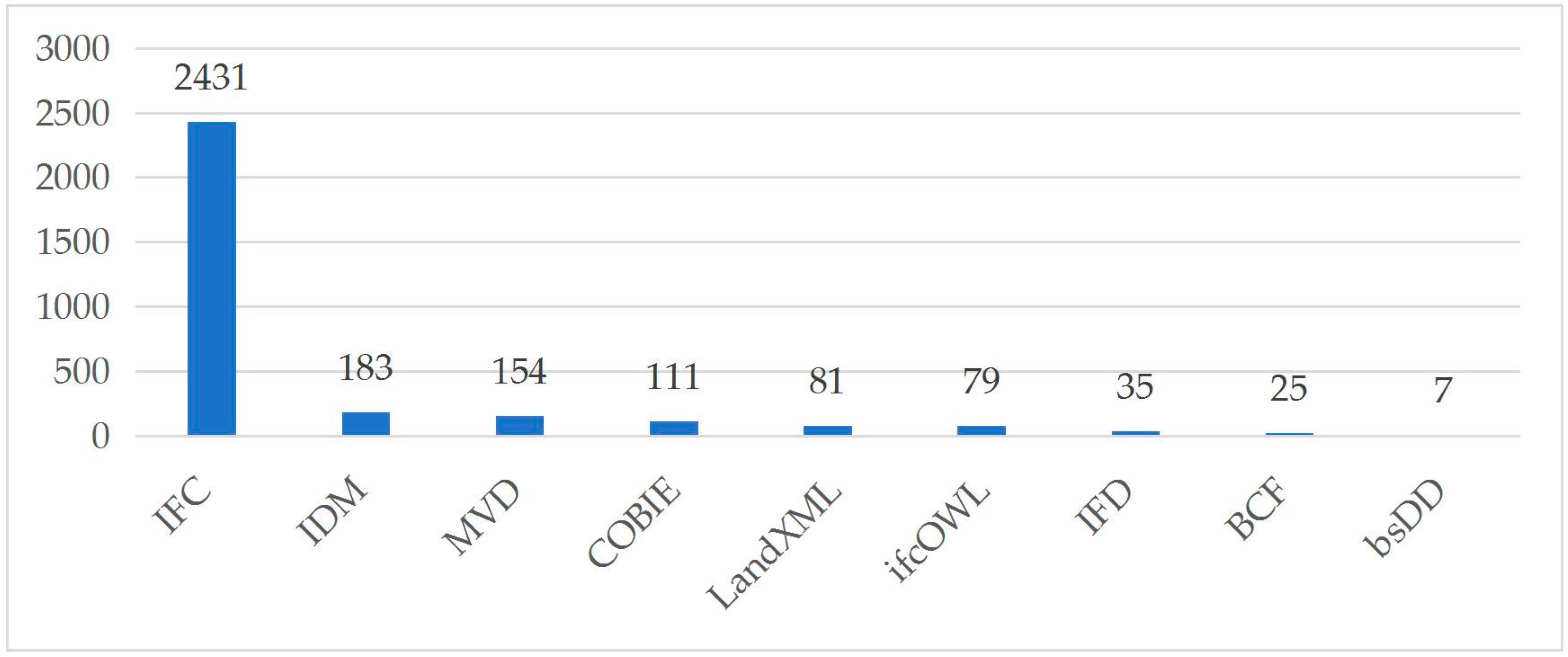
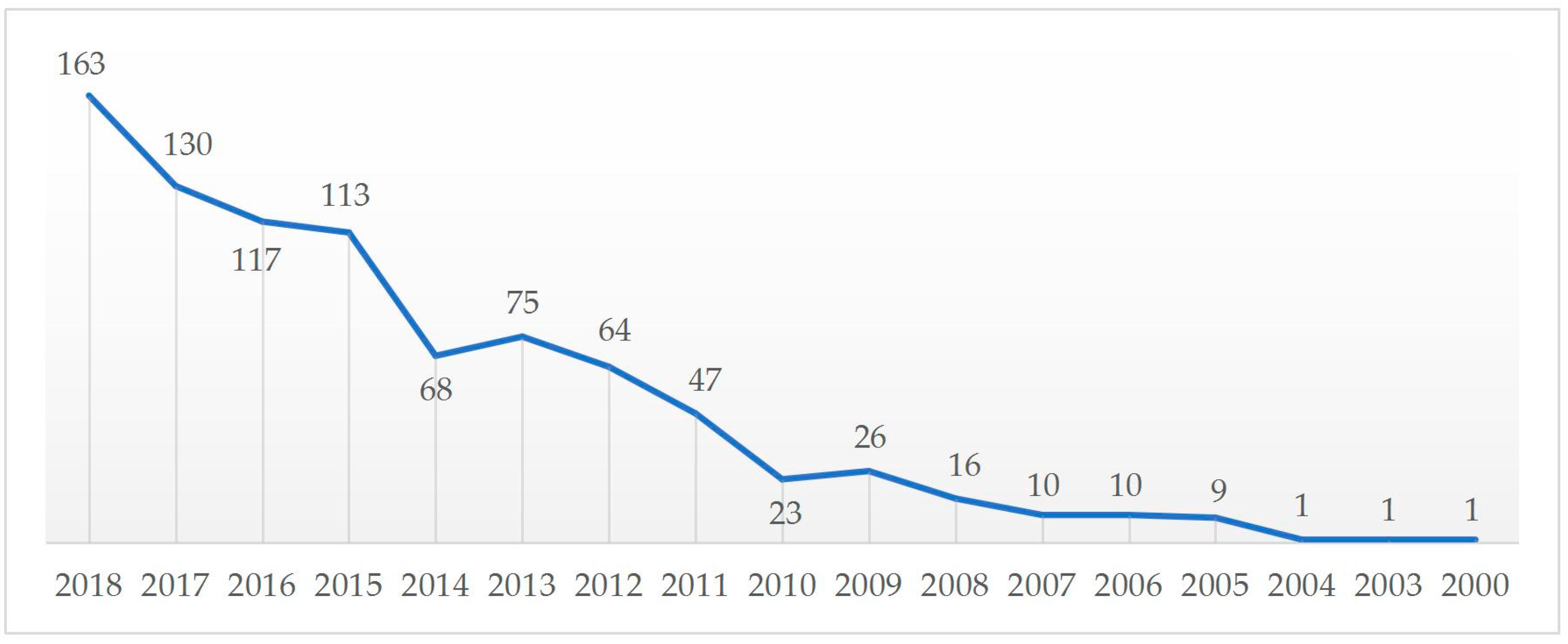
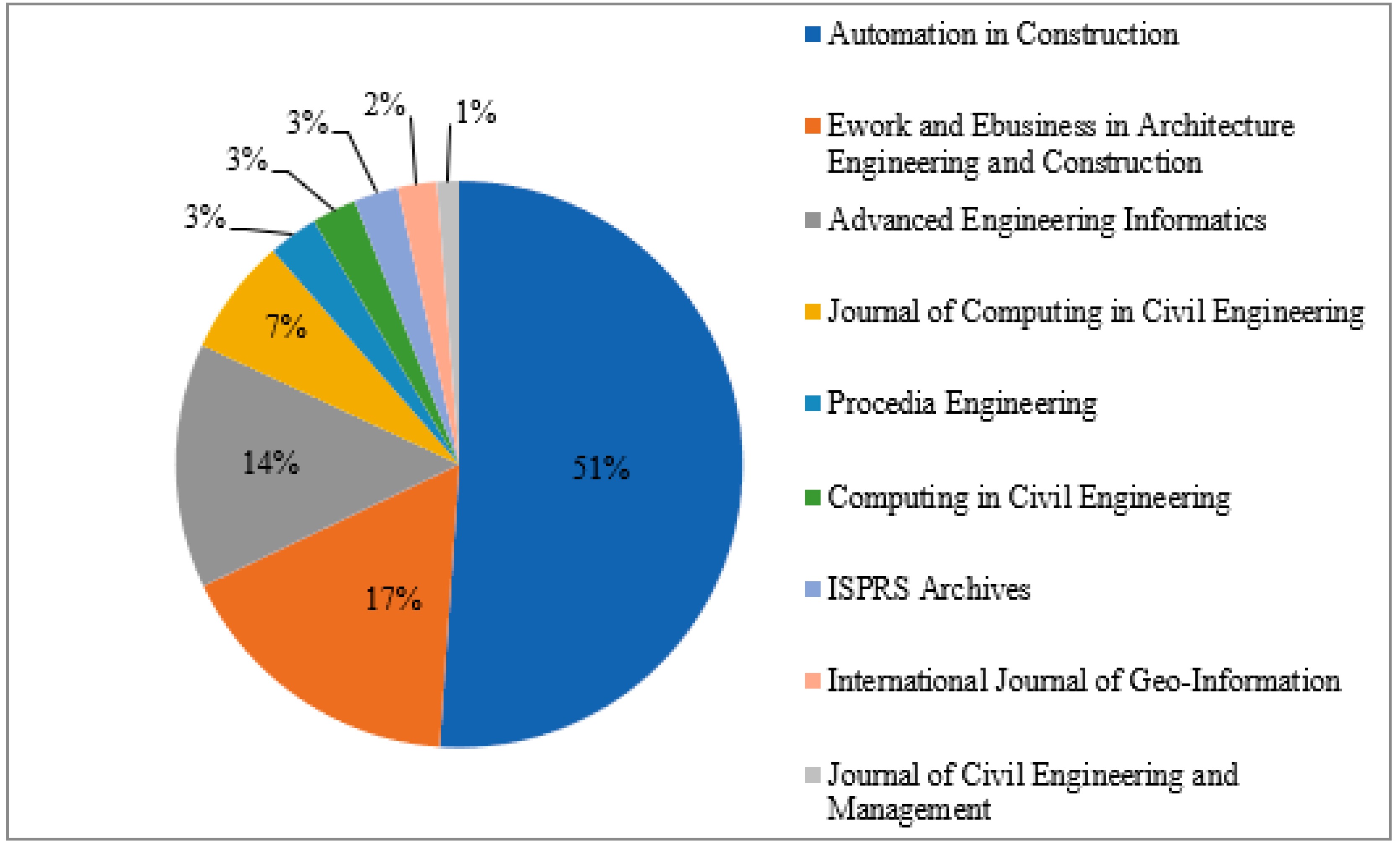
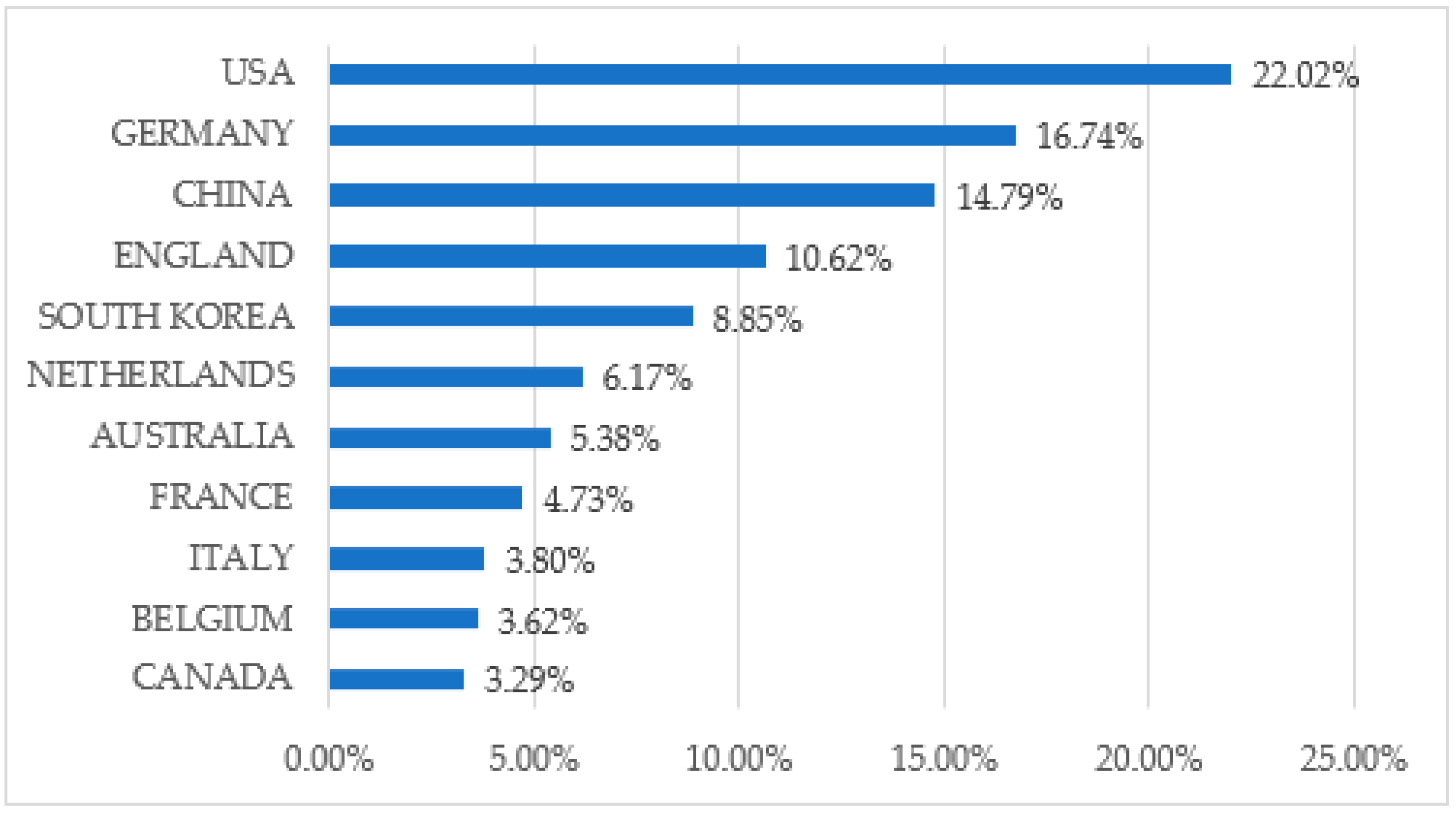
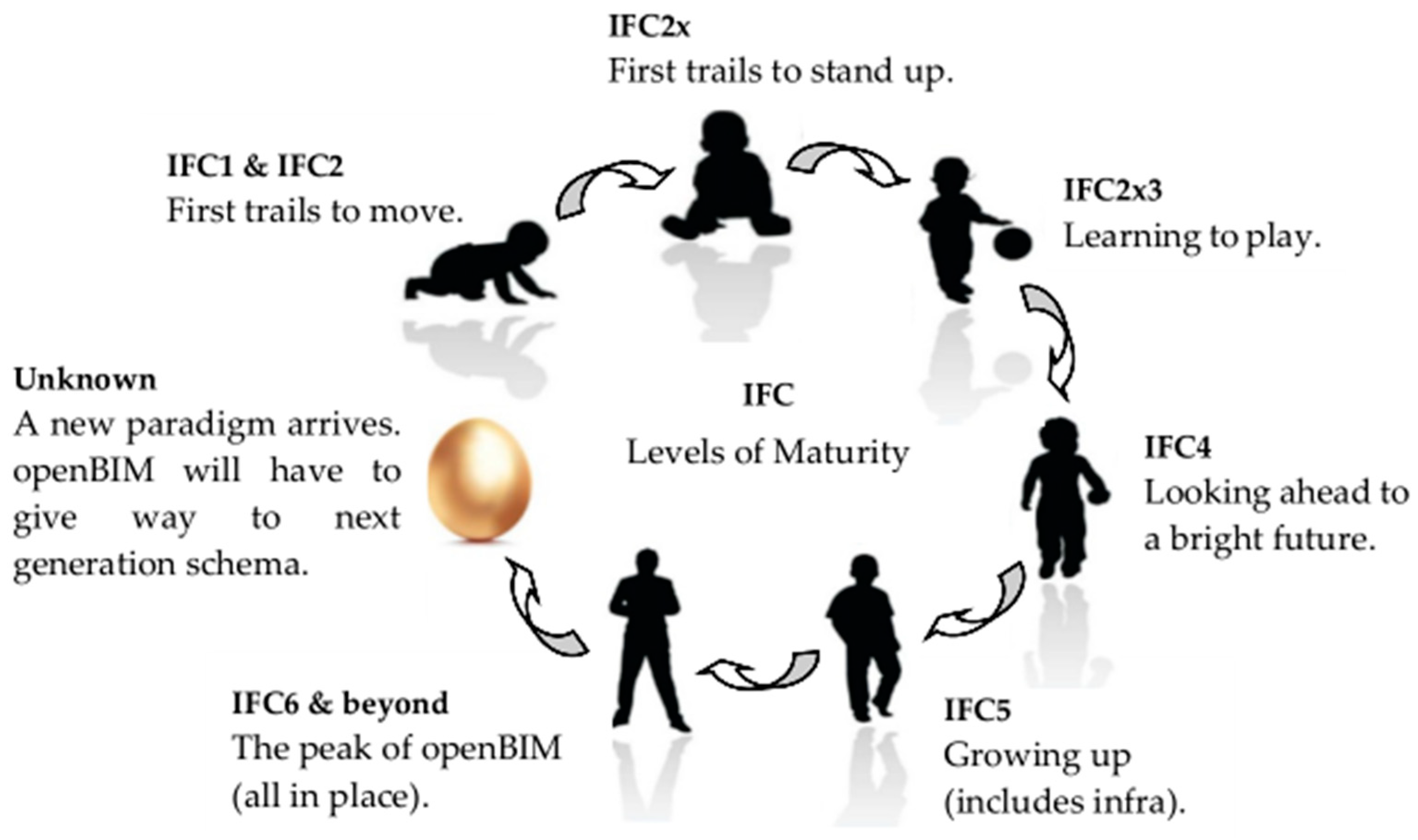
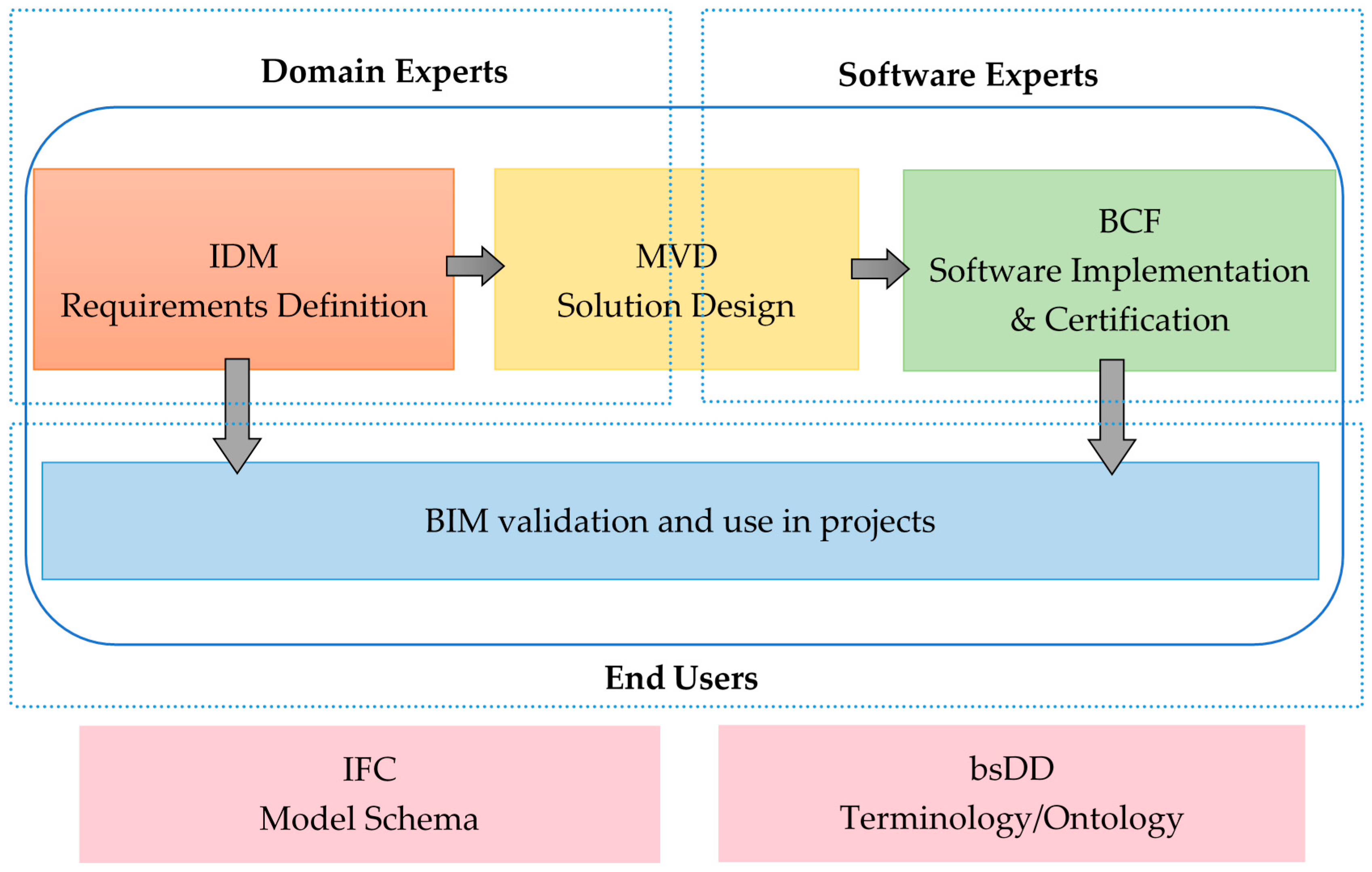
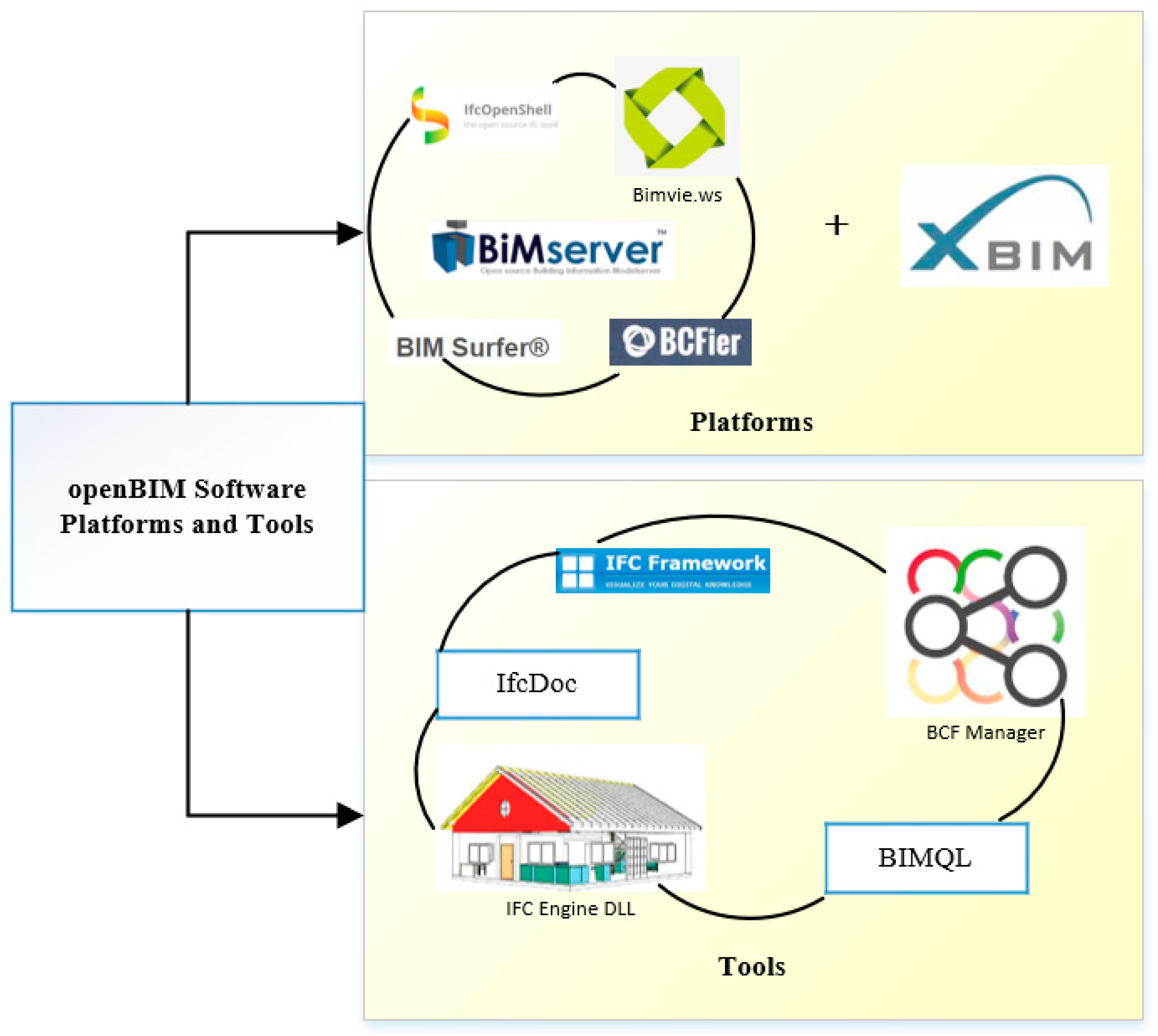
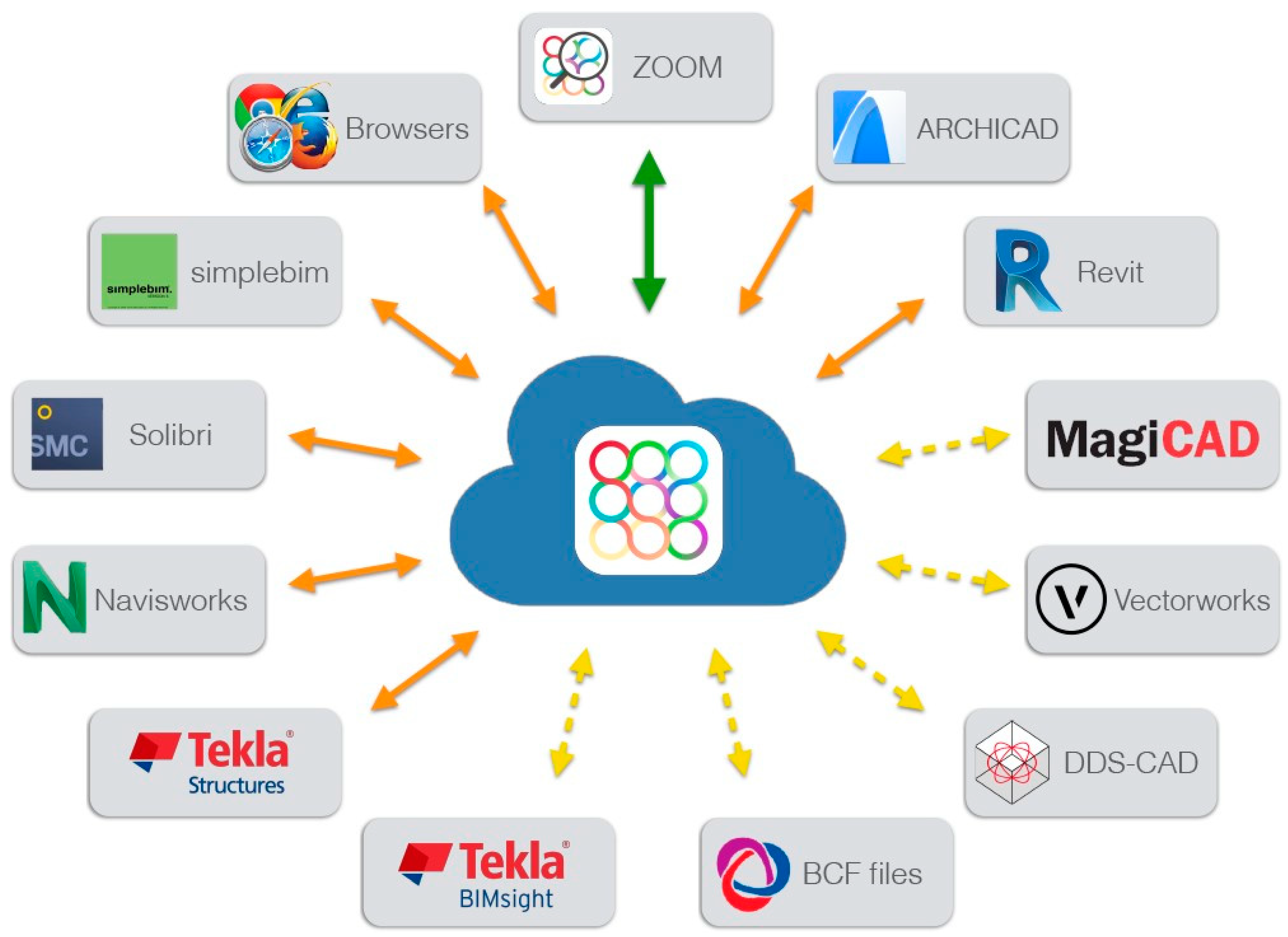
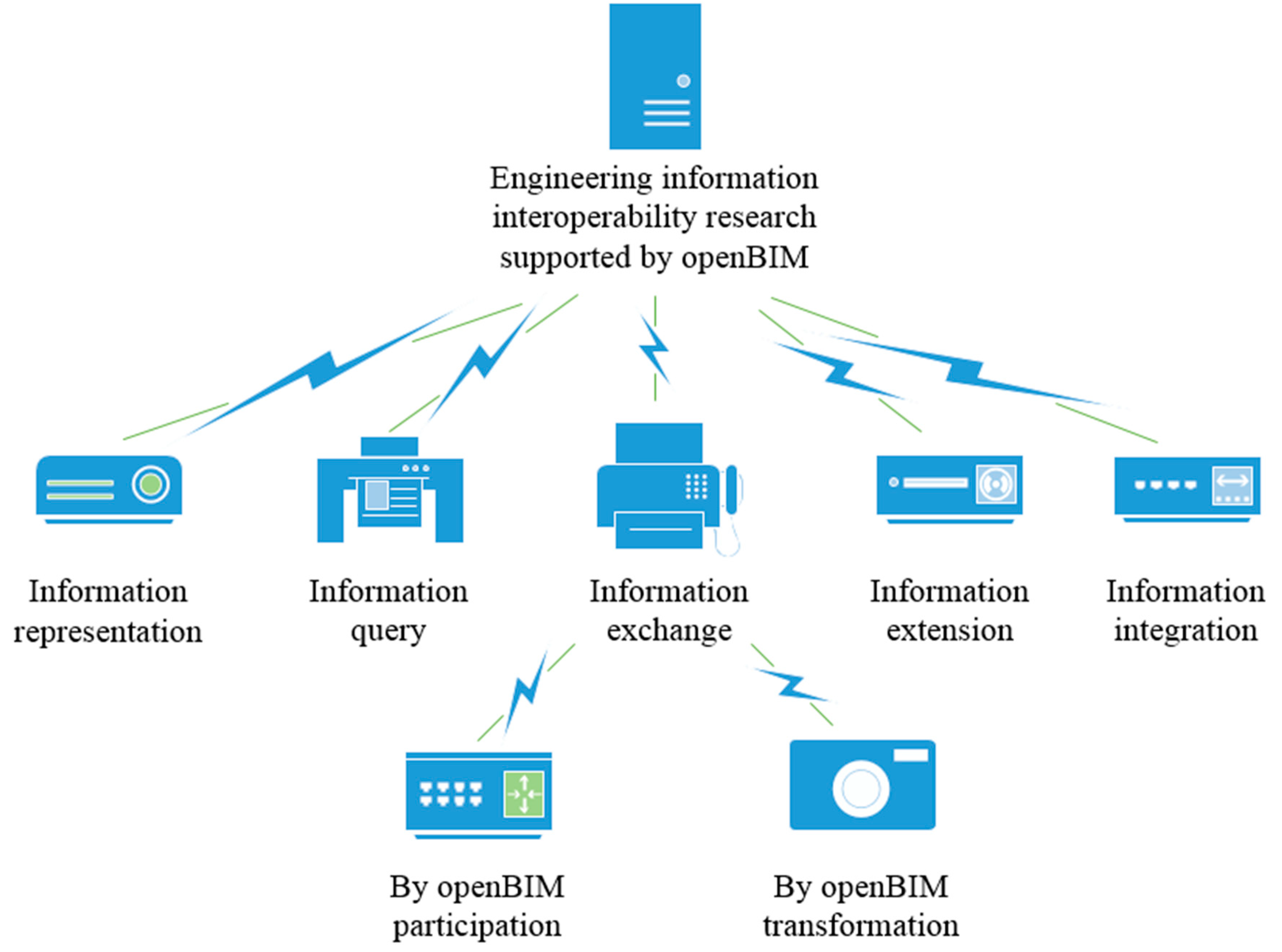
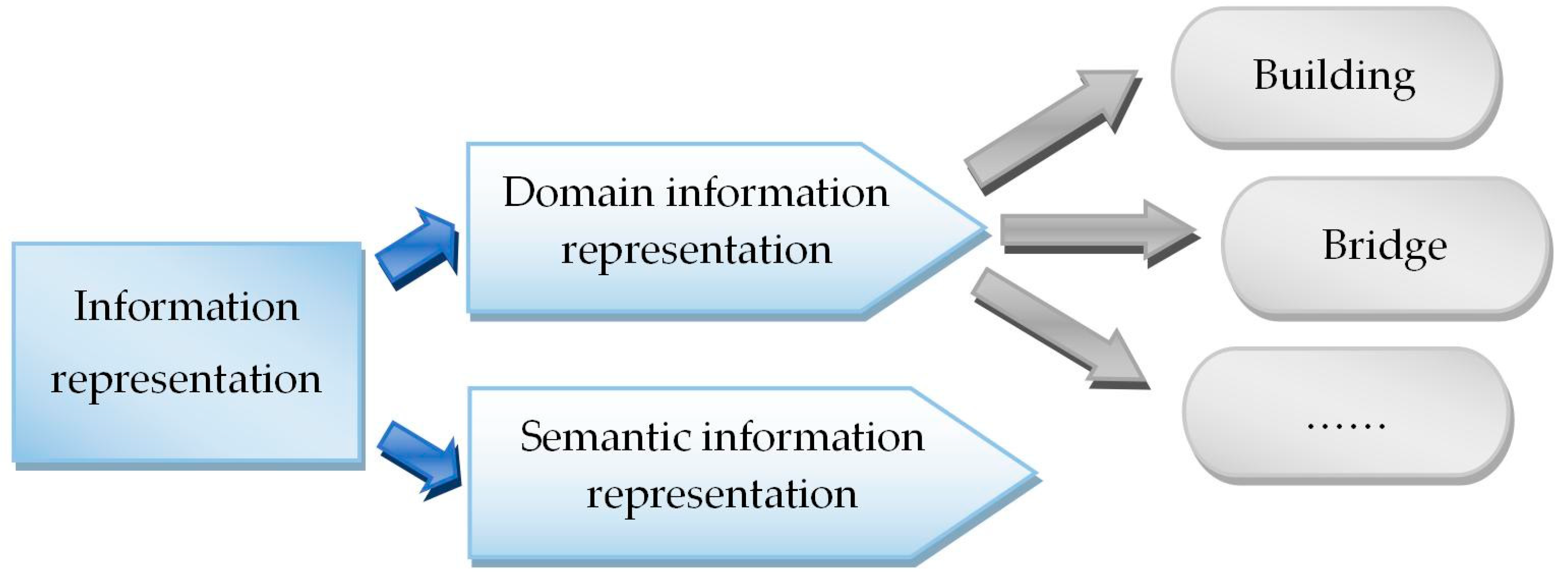
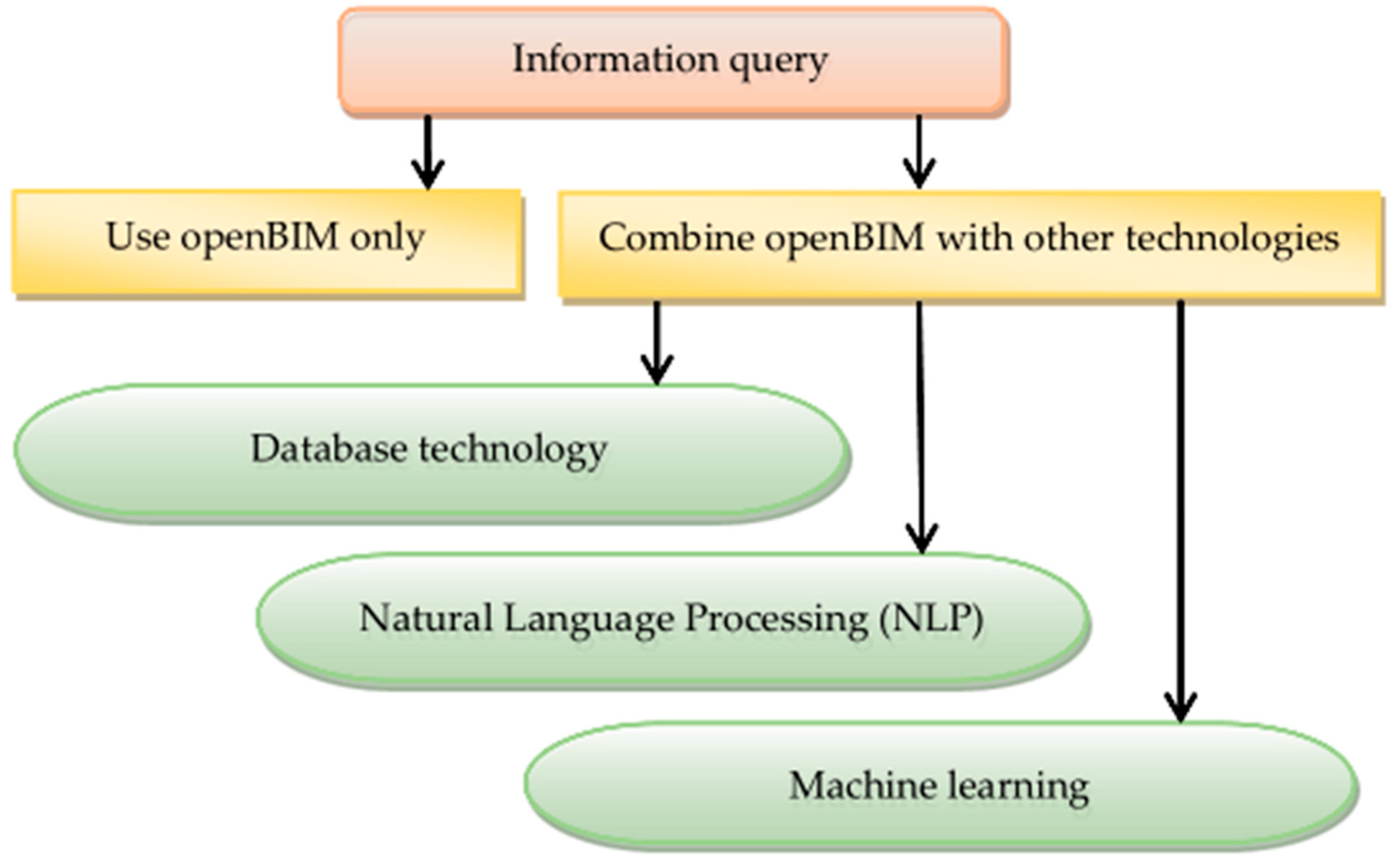
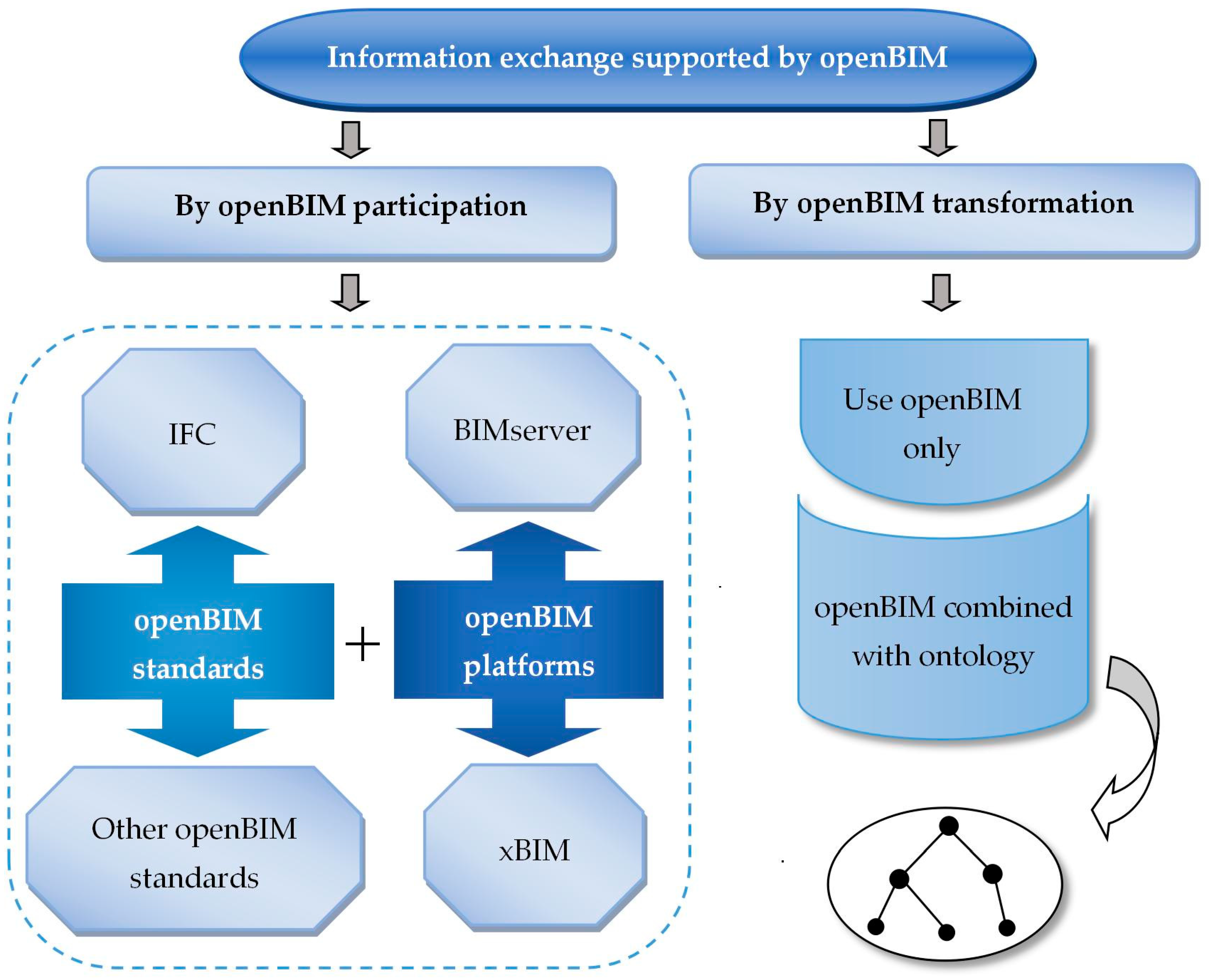

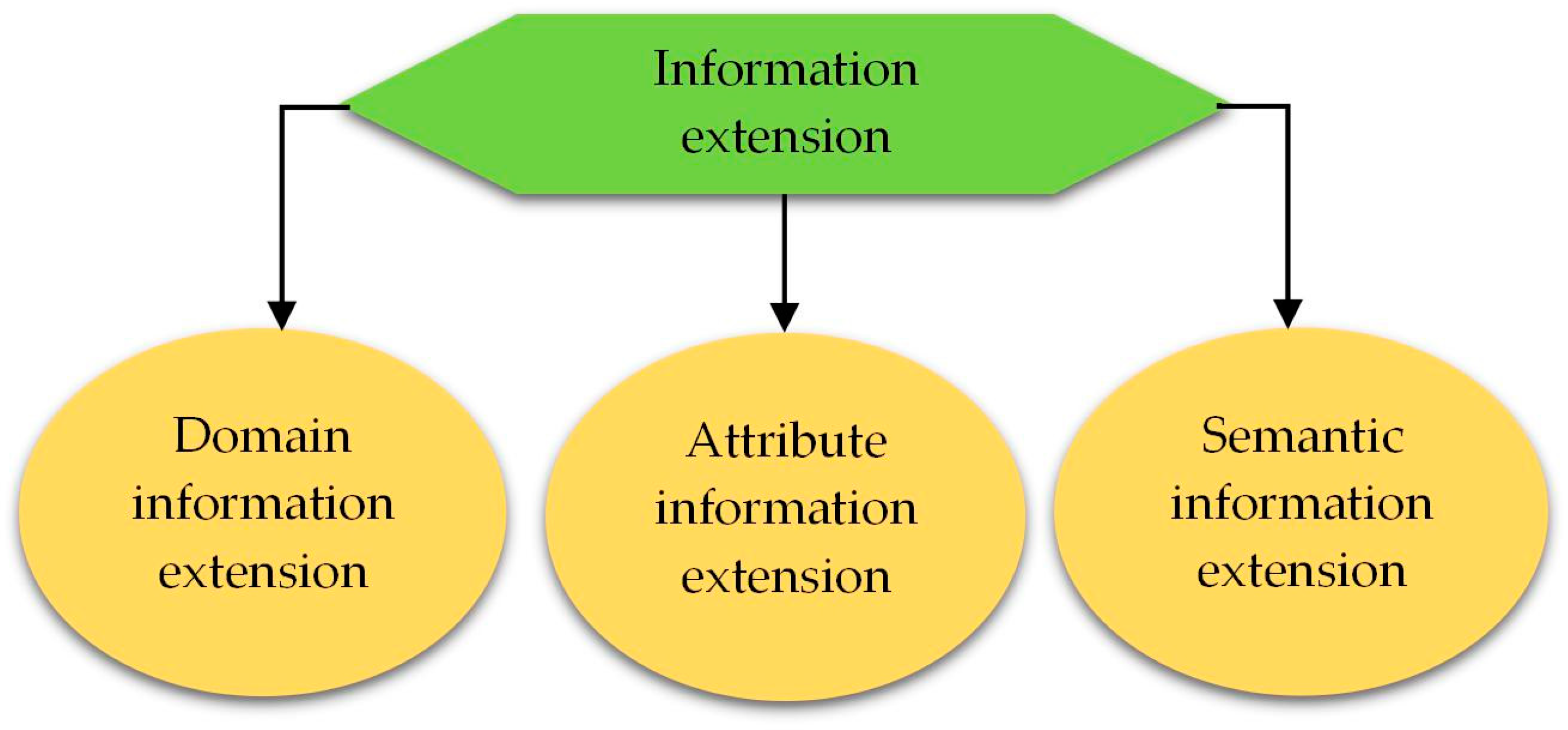
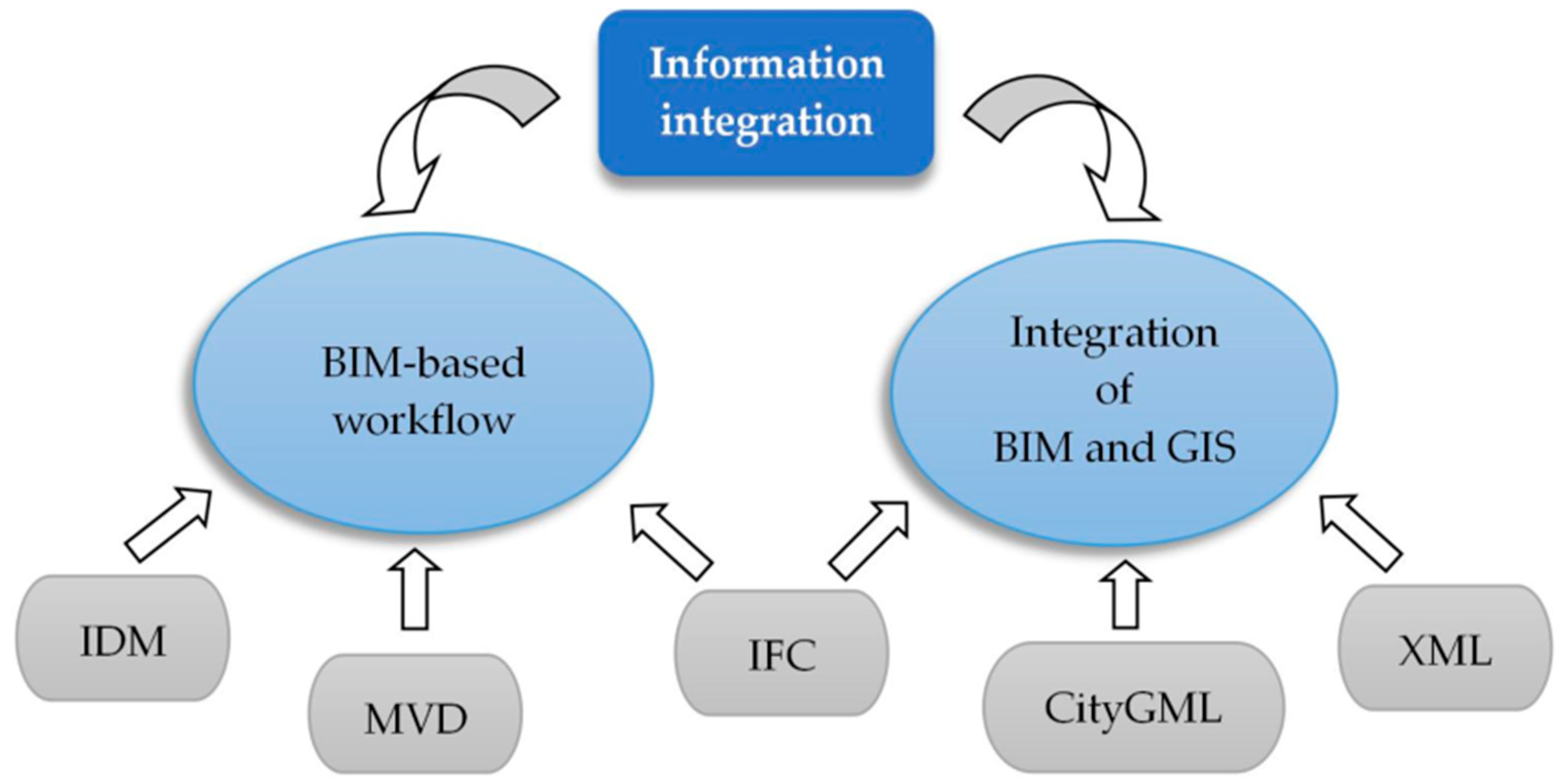
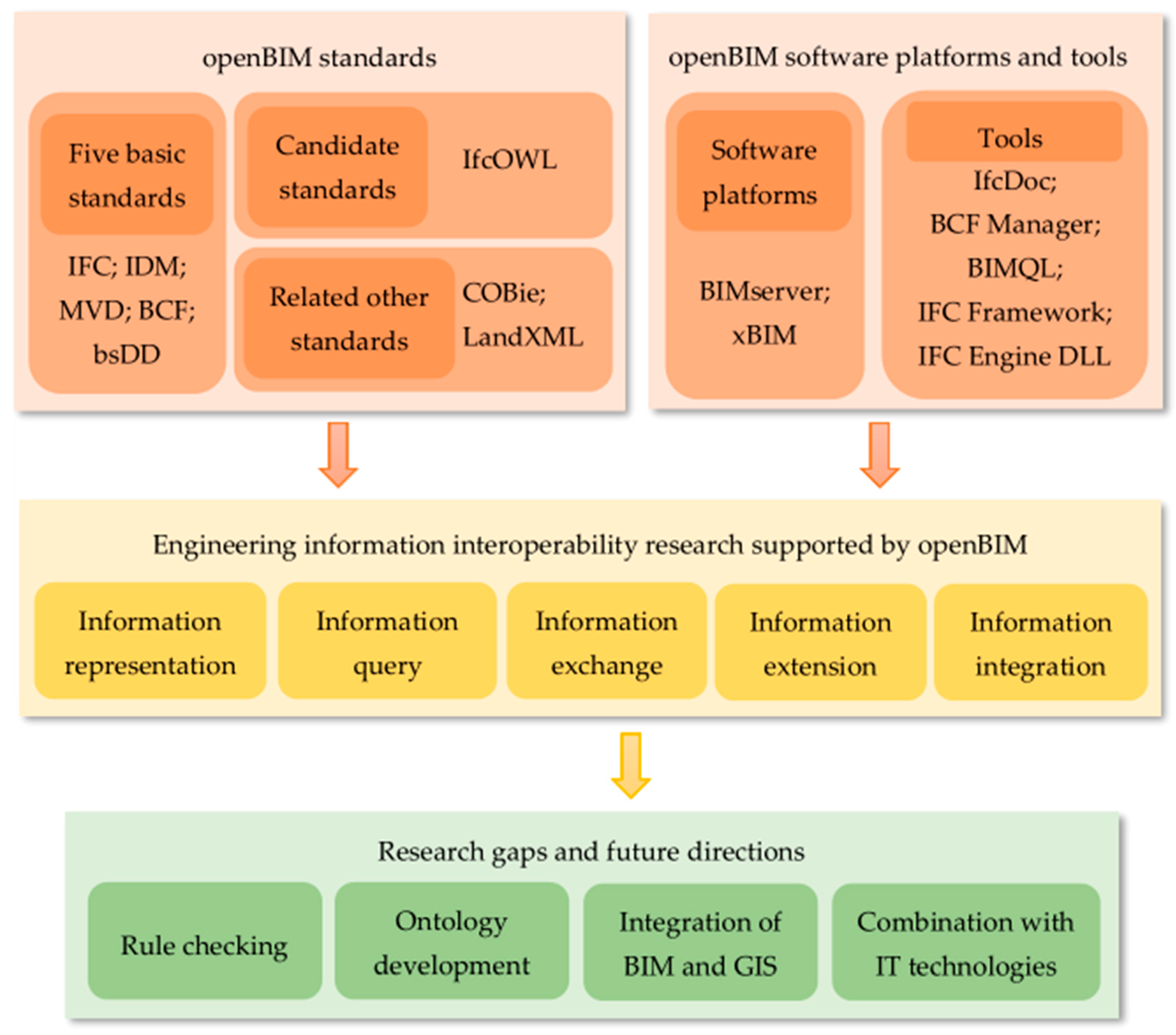
| Scopus | Web of Science (Core Collection) | Engineering Village | CNKI | Science Direct | Total | ||
|---|---|---|---|---|---|---|---|
| 1 | IFC | 738 | 392 | 620 | 534 | 147 | 2431 |
| 2 | IDM | 56 | 31 | 49 | 38 | 9 | 183 |
| 3 | MVD | 43 | 28 | 46 | 21 | 16 | 154 |
| 4 | COBie | 47 | 19 | 32 | 9 | 4 | 111 |
| 5 | LandXML | 26 | 15 | 20 | 13 | 7 | 81 |
| 6 | ifcOWL | 22 | 22 | 21 | 7 | 7 | 79 |
| 7 | IFD | 4 | 8 | 1 | 22 | 0 | 35 |
| 8 | BCF | 8 | 9 | 5 | 1 | 2 | 25 |
| 9 | bsDD | 2 | 3 | 2 | 0 | 0 | 7 |
| Total | 946 | 527 | 796 | 645 | 192 | 3106 |
| Name | What It Does |
|---|---|
| IFC Industry Foundation Classes | Transports information or data |
| IDM Information Delivery Manual | Describes processes |
| MVD Model View Definitions | Translates processes into technical requirements |
| BCF BIM Collaboration Format | Change coordination |
| bsDD buildingSMART Data Dictionary | Defines BIM objects and their attributes |
| Research Direction | Specific Classification | Reference |
|---|---|---|
| Information representation | Domain information representation | Ma et al. [23]; Sacks et al. [24] |
| Semantic information representation | Sacks et al. [25]; Pauwels et al. [26] | |
| Information query | Use openBIM only | Mazairac et al. [20]; Khalili et al. [27]; Kang [10]; Nepal et al. [28] |
| Combine openBIM with other technologies | Ghang et al. [29]; Lin et al. [30]; Kuo et al. [31] | |
| Information exchange | By openBIM participation | Hu et al. [32]; Lee et al. [33]; Solihin et al. [34]; Choi et al. [35]; Park et al. [36]; Caldas et al. [37]; Babič et al. [38]; Caffi et al. [39]; Ding et al. [40]; Lu et al. [41]; Hu et al. [42]; Edmondsona et al. [43]; Vanlande et al. [44]; Lin et al. [45]; Jeong et al. [46]; Wang et al. [47]; Venugopal et al. [48]; Lee et al. [49]; Lee et al. [50]; Lee et al. [51]; Pärn et al. [52]; Alreshidi et al. [53]; Lee et al. [54]; Du [55]; Beetz et al. [56]; Isikdag [57]; Ma et al. [58]; van Berlo et al. [59]; Solihin et al. [60] |
| By openBIM transformation | Solihin et al. [61]; Oldfield et al. [62]; Terkaj et al. [63]; Le et al. [64]; Lee et al. [65]; Pauwels et al. [66] | |
| Information extension | Domain information extension | Lee et al. [67]; Ji et al. [68] |
| Attribute information extension | Patacas et al. [69] | |
| Semantic information extension | Venugopal et al. [70]; Belsky et al. [71]; Fahad et al. [72] | |
| Information integration | BIM-based workflow | Andriamamonjya et al. [73] |
| Integration of BIM and GIS | Laat et al. [74]; Jusuf et al. [75]; Liu et al. [76]; El-Mekawy et al. [77]; Zhu et al. [78]; Kang et al. [79]; Amirebrahimi et al. [80]; Teo et al. [81] |
| Building Life Cycle Classification | Literature |
|---|---|
| Design | Hu et al. [32]; Lee et al. [33]; Solihin et al. [34]; Choi et al. [35] |
| Construction | Park et al. [36]; Caldas et al. [37]; Babič et al. [38]; Caffi et al. [39]; Ding et al. [40] |
| Operation and Maintenance | Lu et al. [41]; Hu et al. [42]; Edmondsona et al. [43] |
| Life cycle | Vanlande et al. [44]; Lin et al. [45]; Jeong et al. [46]; Wang et al. [47] |
| Classification | Literature | OpenBIM Transformation |
|---|---|---|
| Use openBIM only | Solihin et al. [61] | IFC to BIMRL |
| Oldfield et al. [62] | IDM to MVD | |
| openBIM combined with ontology | Terkaj et al. [63] | IFC EXPRESS to OWL |
| Le et al. [64] | LandXML to RDF | |
| Lee et al. [65] | OWL/XML to mvdXML | |
| Pauwels et al. [66] | IFC EXPRESS to OWL |
© 2019 by the authors. Licensee MDPI, Basel, Switzerland. This article is an open access article distributed under the terms and conditions of the Creative Commons Attribution (CC BY) license (http://creativecommons.org/licenses/by/4.0/).
Share and Cite
Jiang, S.; Jiang, L.; Han, Y.; Wu, Z.; Wang, N. OpenBIM: An Enabling Solution for Information Interoperability. Appl. Sci. 2019, 9, 5358. https://doi.org/10.3390/app9245358
Jiang S, Jiang L, Han Y, Wu Z, Wang N. OpenBIM: An Enabling Solution for Information Interoperability. Applied Sciences. 2019; 9(24):5358. https://doi.org/10.3390/app9245358
Chicago/Turabian StyleJiang, Shaohua, Liping Jiang, Yunwei Han, Zheng Wu, and Na Wang. 2019. "OpenBIM: An Enabling Solution for Information Interoperability" Applied Sciences 9, no. 24: 5358. https://doi.org/10.3390/app9245358
APA StyleJiang, S., Jiang, L., Han, Y., Wu, Z., & Wang, N. (2019). OpenBIM: An Enabling Solution for Information Interoperability. Applied Sciences, 9(24), 5358. https://doi.org/10.3390/app9245358





